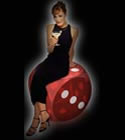In a two-player pot, weak hands can be played in good position, and different two-way hands have a lot of value.
But in a multiway pot, these hands are total trash.
hands that do very well in a multiway pot tend not to do as well in a heads-up pot.
In a three-handed pot, you are laying 2-to-1on your side if you have only one side.
This is one of the trickiest spots to be in, because frequently the pot becomes three-handed and you find yourself fighting for one of the halves. In this case, you may be taking the worst of it.
As you can see, the high hand in a short-handed pot tends to do better, because a low hand generally requires a lot of improvement to counterfeit the high hand.
Also , you usually can tell when you are not competing against another high hand, unless you are against a low hand with some sort of high draw.
In a heads-up pot, the high hand is usually the best hand to have, but you also would like a low draw, even if it is a poor one.
You may be sharing the high hand with your opponent, which happens more often that you might think, so having the chance to make a low on the river may get you three-quarters of the pot.
This situation can be reversed if your opponent has a better low draw than you do.
Thus, even though you have the nuts heads-up, you have to play accordingly, since you may be splitting the pot and your opponent may have a draw at you.
Remember, getting three-quartered happens very often, and you must pay a lot of attention to this.
So when you hold what looks like a big hand but there are many possibilities the other way, you must plan for these possibilities and determine the best way to deal with them.
If often may be correct to check a hand, even though it looks like the best hand that moment, because many cards can come to beat you.
Even though you have the nuts for high and no low is yet made, if your opponent plays back at you, you could be against the same high hand as you hold, plus a low draw.
In this situation, you want to check and call on fourth street, no matter what hits. (Also notice that very few cards can come on fourth street that won’t look scary.)
When the game becomes five-handed or less, which often happens when two or three players are walking or eating, most people at the table will continue to play along the same lines.
That is, they won’t adjust their game. They will be waiting on an ace-deuce and still will want four big cards suited up. In other words, they will play just as though the game were full.
So when the game becomes short-handed, you can begin to steal a lot of blinds. Most opponents will give up their blinds, as they have not adjusted to a short-handed game.
You can play a lot more hands in this situation, plus you can maneuver many opponents because they will tend to go out.
Also, since the pot won’t be very big, the typical player will not want to go too far with his hand. In addition, he usually will play cautiously and try to conserve his chips until the game fills up again.
Introduction / Automatic Play / High Versus Low in Three-Handed Pots / Loose Games / Multiway pot Versus Short-Handed Play / Scare Cards / Getting Counterfeited / Getting Quartered / Playing Against Steamers / Playing Against Tight, Solid Players / Your Playing Style / Fluctuations / Pot-Limit Omaha Eight-or-Better / Afterthought


